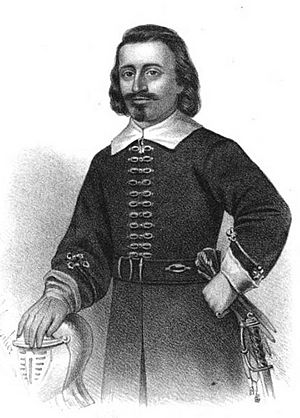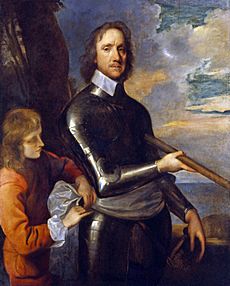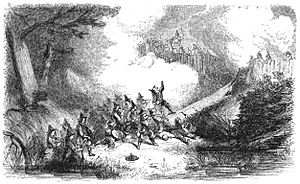John Leverett facts for kids
Quick facts for kids
John Leverett
|
|
|---|---|

Engraved portrait of Leverett in his military uniform
|
|
| Governor of Acadia/Nova Scotia (military) | |
| In office 1654–1657 |
|
| Preceded by | Charles de Saint-Étienne de la Tour |
| Succeeded by | Sir Thomas Temple (as proprietor of Nova Scotia) |
| 19th Governor of the Massachusetts Bay Colony | |
| In office 1673–1679 |
|
| Preceded by | Richard Bellingham |
| Succeeded by | Simon Bradstreet |
| Personal details | |
| Born | baptized 7 July 1616 Boston, Lincolnshire, England |
| Died | 16 March 1679 (aged 62–63) Massachusetts Bay Colony |
| Signature |  |
| Military service | |
| Allegiance | Parliament army Massachusetts Bay Colony militia |
| Years of service | 1644–1648 (Parliament army) 1649–1673 (Massachusetts militia) |
| Rank | Captain (Parliament army) Major-general (Massachusetts militia) |
| Commands | Massachusetts militia |
| Battles/wars | English Civil War |
John Leverett (born 1616 – died 1679) was an important leader in the early American colonies. He was a merchant, a soldier, and served as the second-to-last governor of the Massachusetts Bay Colony.
Born in England, he moved to Massachusetts when he was a teenager. He became a successful merchant and served in the colony's military. In the 1640s, he even returned to England to fight in the English Civil War.
Leverett believed in more religious freedom than many other leaders in the colony. He also thought the colony should have more independence from the English king. These strong beliefs eventually led to problems with England. Despite some disagreements, he was popular with his soldiers and was elected governor many times from 1673 until his death in 1679. As governor, he led the colony during King Philip's War and helped expand its land by buying claims in what is now Maine.
Contents
Early Life and Family
John Leverett was born in Boston, England, and was baptized on July 7, 1616. His father, Thomas Leverett, was a close friend of John Cotton, a Puritan religious leader. Thomas Leverett was also an elder in their church.
We don't know much about John's mother, Anne Fisher, except that she had 16 children. In 1633, when John was about 17, his family moved to the New World. They settled in the capital of the Massachusetts Bay Colony, which was also called Boston.
In 1639, John Leverett married Hannah Hudson. They had one son, Hudson, in 1640. Sadly, Hannah died in 1643. In 1640, John became a "freeman," which meant he could vote and hold office in the colony.
Military and Business Ventures
In 1639, Leverett joined the Artillery Company of Massachusetts. This group was a place for people who sometimes disagreed with the strict religious rules of the colony's Puritan leaders. Many members, including Leverett, believed in more religious freedom.
Members of the Artillery Company were also involved in trade. Leverett often worked with other merchants like Edward Gibbons and Robert Sedgwick. For example, he owned part of a ship with Gibbons that was lost off the coast of Virginia. Sometimes, his military and business roles overlapped.
In the 1640s, Gibbons helped the French governor of Acadia, Charles de la Tour, in a local conflict. In return, Gibbons and Leverett gained special trading rights with the French.
Fighting in the English Civil War
Around 1644, John Leverett traveled to England. There, he joined the Parliamentary army led by Oliver Cromwell during the English Civil War. He served as a cavalry commander and was known for his bravery.
He returned to Massachusetts in 1645. That same year, he married Sarah Sedgwick, the daughter of Robert Sedgwick. They had 12 children together, but only six lived to adulthood.
His time in England made him believe even more strongly in religious tolerance. He often pushed for this idea in Massachusetts, even though many conservative Puritan leaders disagreed. They wanted everyone to follow their strict religious rules.
Becoming a Political Leader
After returning from England, Leverett became very active in Massachusetts politics. In 1651, he was elected as one of Boston's representatives in the colony's main government, called the General Court. He even served a short time as the Speaker of the House.
Throughout the 1650s and 1660s, he served five terms in the General Court. He was also a popular leader in the colonial militia. In 1652, he was elected captain of several different militia groups. However, colonial law said officers could only hold one position. He had to give up one of his posts, but he was allowed to keep his role in the Artillery Company.

In 1652, Governor John Endecott sent a group to find the colony's northern border. They mistakenly thought the border was much further north, near what is now Lake Winnipesaukee in New Hampshire. This new boundary included several small settlements in southern Maine.
Endecott sent Leverett and other leaders to bring these settlements under Massachusetts rule. This led to the creation of York County, Massachusetts. Leverett became very interested in developing land in Maine and bought a lot of property there.
From 1655 to 1662, Leverett served as Massachusetts' representative in England. During the 1650s, when Oliver Cromwell was in charge of England, Massachusetts benefited from Leverett's good relationship with him. Cromwell did not strictly enforce trade laws against the colony. He also overlooked complaints about Massachusetts' harsh treatment of people with different religious views, even though Leverett personally disagreed with those strict rules.
Military Control of Acadia
In 1651, England and the Netherlands went to war. When news reached the American colonies, there were rumors that the Dutch in New Amsterdam (now New York) were planning to attack with Native American allies. Leverett and Robert Sedgwick saw a chance to help their trading businesses by removing the Dutch as competitors.
In 1653, Leverett was sent to New Amsterdam to discuss the situation. While there, he carefully observed the Dutch defenses. He then went to England with Sedgwick to ask Oliver Cromwell for military help against the Dutch.

Cromwell agreed and sent Sedgwick and Leverett with ships and troops to fight the Dutch. However, by the time the colonial forces were ready in 1654, England and the Netherlands had made peace.
Instead, Sedgwick decided to attack the French in nearby Acadia (now Nova Scotia). French privateers (pirates working for the government) often attacked English ships. In July 1654, Sedgwick captured the main Acadian ports, including Port Royal.
Sedgwick then put Leverett in charge of governing Nova Scotia. Leverett ruled the province for three years, until May 1657. During this time, he and Sedgwick controlled most of the trade in French Acadia. Leverett paid for much of the occupation himself and later asked Cromwell's government for repayment.
Leading the Colony
From 1663 to 1673, John Leverett was a major-general of the Massachusetts militia. He was also regularly elected to the General Court or the council of assistants. During this time, he helped strengthen Boston's defenses. He also visited settlements in New Hampshire and southern Maine, where some colonists were unhappy with Massachusetts rule.
After Charles II became king of England again, he began to pay closer attention to all the colonies. In 1665, King Charles sent four officials to Massachusetts. They were told to make the colony agree to new rules, including allowing more religious freedom and following English trade laws.
The arrival of these officials worried the colonial government. Leverett was part of a group that wrote a petition to the king, asking him to recall the officials. The petition said the officials were trying to harm the colony's independence.

Leverett served as deputy governor from 1671 to 1672. After Governor Richard Bellingham died, Leverett became governor. His time as governor was most notable for King Philip's War, a major conflict with Native American tribes.
During his governorship, the colony also faced increasing threats to its charter (its founding document) from the king. In 1677, Massachusetts angered the king by buying land claims in Maine. King Charles had wanted that land for his own son. An English official, Edward Randolph, reported in 1676 that Leverett believed the colony was not bound by the king's laws unless they benefited the colony.
Although Leverett supported religious tolerance, many in the colony did not. Baptists were able to worship openly in Boston during his time as governor. However, some Quaker historians have criticized him for harsh anti-Quaker laws passed in 1677.
Death and Lasting Impact
John Leverett died while still in office on March 16, 1679. He was buried at the King's Chapel Burying Ground in Boston.
His descendants include his grandson, John, who became the seventh President of Harvard College. Another descendant was Leverett Saltonstall, a 20th-century governor of Massachusetts. The town of Leverett, Massachusetts is named after his grandson.
Cotton Mather, a famous colonial writer, praised Leverett. He wrote that Leverett was popular with the people and quickly rose to the highest office. Mather also said Leverett was known for his courage in his younger years and his wisdom and fairness in his later years.

